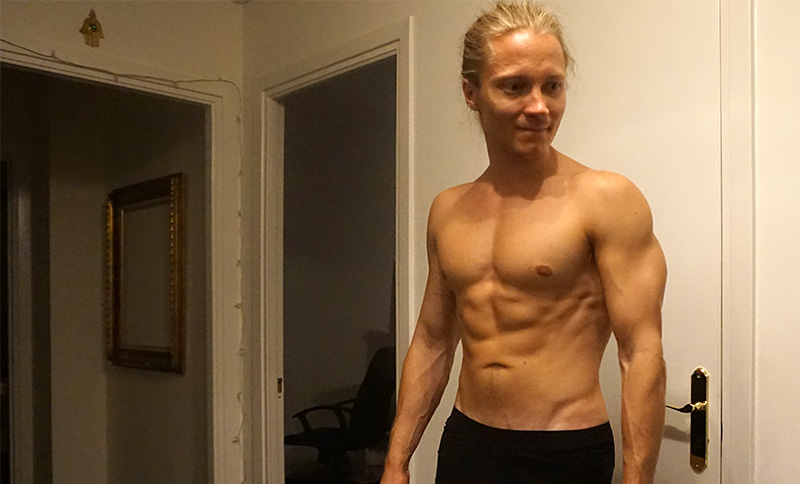
People that successfully gain muscle without gaining fat do two things very well:
First, they make sure the most important factor for muscle growth is set up correctly, which is resistance training.
Then, they set up their diet to allow the growth to take place.
In today’s post you’re going to learn how to do this, so that you’re not looking good only for a few months during the summer, but always!
Let’s get started:
Table of Contents
Why You Should Gain Muscle Without Gaining Fat
Before learning how to gain muscle without gaining fat, let me quickly explain why choosing this route is smart.
During the first few years of my fitness journey I was known as the “yoyo dieting guy”.
I used to cut for a long time, then bulk hard, then cut for a long time again, then bulk even harder…
…you see where I’m going with this, right?
In fact, here’s a picture of my journey:
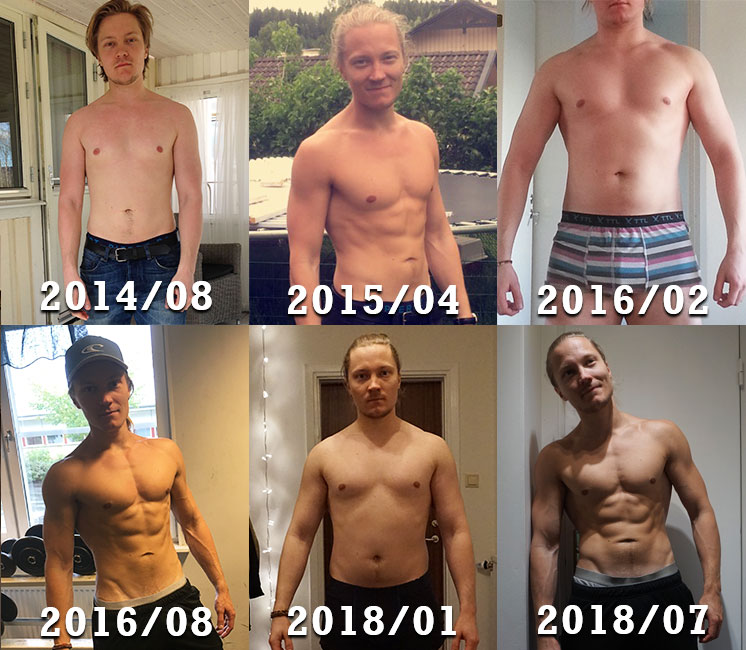
Now:
If you asked me to do this journey over again, I would have done it differently.
Why?
Well, in hindsight I would’ve much rather stayed lean throughout my journey, as I believe it’s more enjoyable.
Also, being lean makes me feel better both mentally and physically.
Furthermore, staying lean is a lot healthier than what fluctuating heavily up and down in weight are.
And lastly, by staying lean, the rate of muscle growth can be improved slightly. This happens both directly, following improved hormonal environment for growth in the body when you’re around 10-15 % body fat:
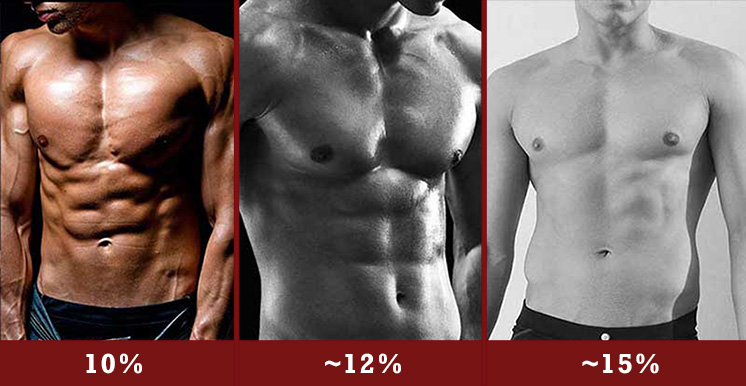
And indirectly because you spend less time cutting.
Okay, so now you might be wondering:
Why didn’t I stay lean throughout my journey then?
Well, first of all, because I made a few mistakes during both my cutting and bulking phases.
And second, because of greed and impatience…
Where I wanted to gain muscle quickly during my bulks and lose fat quickly during my cuts. You could say I was naive, and well, I would say that I was very naive hehe.
Anyways, I’m still happy with my results, and best of all, I’ve learned from my mistakes.
So, let’s look at how to gain muscle without gaining fat, exactly what I should have done and how you can do it correctly from the beginning!
Dial in the Most Important Aspect for Muscle Growth FIRST
Want to know the biggest mistake that I made? Which is also a mistake that I see people make all the time.
Well, here it is:
Not accepting that muscle growth follows improved training performance and not the other way around!
If you’re under the belief that; in order to get big you must eat big. Then it’s time to drop that belief right now!
Because here’s the thing:
Even though it’s true that you must eat enough calories and protein to maximize muscle growth.
If you’re not training correctly, then all the calories and protein in the world won’t do you anything good, other than adding fat to your frame.
Sure you’ll get big, but I’m sure getting fat is not the “big” most of us are looking for.
I think pro natural bodybuilder, author, coach and PhD graduate Eric Helms put it best:
“Nutrition is only permissive to muscle growth, the actual stimulus is training”
And that makes a lot of sense when you stop to think about it:
In fact here’s a good analogy of this:
Imagine a worker trying to build a house.
The worker can’t build the house faster if we give him more materials than he can use every day. In fact, the unused materials will just be piled up around the house in a big ugly mess. Just like body fat will be piled up around the muscles if we eat more than we can use for muscle growth.
So, as you can see, training dictates muscle growth, diet “just” allows it to happen. So, make sure you have a well set up training program!
How to Set up a Good Training Program For Muscle Growth
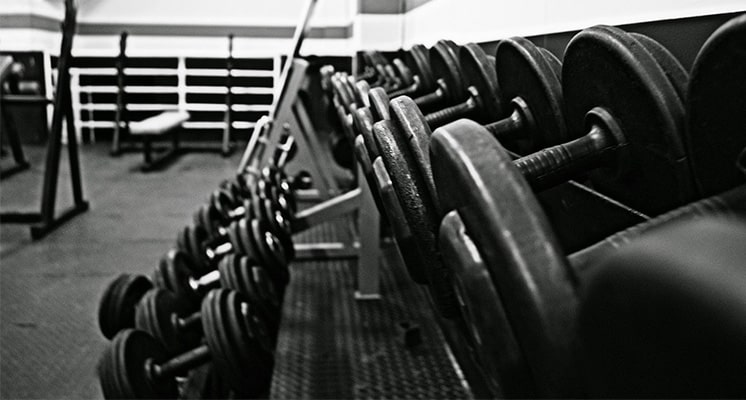
Step 1 – Train For Strength (4-12 rep range)
First of all, you can gain muscle training either for strength or muscular endurance. Muscle growth is about doing more training over time no matter how heavy the training is, as long as the weights are not getting too light.
With that said though, training for strength is usually better during most circumstances. There are two main reasons for this:
- Training for strength is more effective and efficient – When you train with heavy weights you will cause a stimulus for muscle growth immedaitely from the very first rep. If you train with higher reps for muscular endurance you must go to absolute failure and only the last few reps will cause growth. Ineffective and inefficient!
- It’s easier to achieve progressive overload when focusing on strength – When you’re training with a lower rep range it’s easier to make bigger jumps in weights ensuring progressive overload. Now sure, it’s possible to do the same with lighter load training for muscular endurance as well, but it’s a bit more tricky to keep control over your gains. Furthermore, people training for strength are usually more faddish about increasing weight on the bar over time. Which will lead to quicker progressive overload.
Of course you can split your work up and do both strength and muscular endurance work in the same workout session or on different days, that’s a very good strategy to ensure muscle growth.
Step 2 – Use Big Compound Lifts
Training almost exclusively with big compound exercises are hands down the most optimal and effective way to build muscle during your training career.
It’s been shown repeatedly that nothing beats the effectiveness of doing compound lifts for strength and physique development. This is simply because:
- You can lift the most amount of weight with compound lifts.
- It stresses the whole body as one.
- You can go through a full range of motion that is very natural to the body.
Another very important reasons to use all the big compound exercises, is to create a physique that’s symmetrical and proportional.
As I just mentioned, by doing large compound lifts, you make sure your body gets developed as one, and this is crucial when building your physique, especially during your beginner to intermediate stages.
So, here are the 7 exercises that should ideally be included in your training program:
The Most Bang For Your Buck Exercises
First, we got the big four – Which are our main strength and muscle growth drivers, and these are:
- Bench Press (barbell and dumbbell)
- Overhead Press (barbell and dumbbell)
- Squats (Leg press if you’re not built for squatting)
- Deadlifts, regular or Romanian
Then we also have what I call our supplemental compound lifts – And these are in place to build the right proportions, and these are:
- Weighted Pull-ups (Pulldowns if you can’t do Pull-ups)
- Cable Rows (wide grip and close grip)
- Incline Bench Press (barbell and dumbbell)
All the exercises you see above, except for a few isolation exercises which we’ll look at in a moment, are all you need to build an aesthetic physique.
Step 3 – Use a Few Key Isolation Exercises
The main reason why we need to use isolation exercises is because there’s one muscle in particular that needs to be isolated in order to be trained. If you don’t isolate it, it will be underdeveloped.
And that’s your medial delts.
If you leave your medial delts underdeveloped, you will lose out on a huge part of what makes up a lean, muscular and aesthetic looking physique.
The problem with your medial delts is that they’re used in a way that doesn’t let them get hit effectively by any of your compound lifts, not even overhead presses hit you medial delts well enough.
The only way to effectively hit them is when you extend your arms out to the sides, like this:
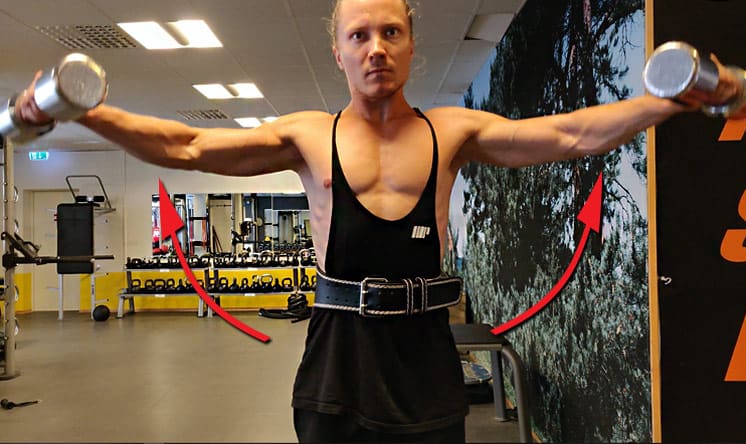
This movement puts your shoulders in a very bad position to lift heavy weights, risking injury. For that reason, you need to use isolation exercises, with lighter weights and higher reps to train your side delts safely and effectively.
Another reason for using isolation exercises are for certain muscle groups that needs a bit more volume to grow. Typically for most people, this would be biceps and rear delts, which are also huge components of an aesthetic physique.
Most people will get decent bicep and rear delt growth from compound lifts like pull-ups and rows. But to get very well-developed biceps and rear delts, these muscles typically require a bit more work. Simply because they’re very fatigue resistant.
And if you were to do that extra work with compound lifts, you would risk overtraining other muscles included in the lift, such as the Lats, Rombs and Traps etc.
Another muscle group that should be trained with isolation exercises, are the one who people think are made in the kitchen.
Yes, you guessed it, I’m talking about your abs!
Here’s the thing:
Abs are revealed in the kitchen, but just as with any other muscle, they’re built in the gym.
Now, heavy compound lifts will train your abs. But they will mainly train your internal, stabilizing abs, such as your transverse abdominis, and your internal obliques.
To get that six pack to really pop when you’re lean, you must train your rectus abdominis directly, which is done with ab flexion exercises, such as crunches, and leg raises for example.
So, here are the 4 ideal exercises that’ll ensure you’re developing your medial delts, rear delts, biceps and abs completely:
Complete Development Isolation Exercises
- Dumbbell Lateral Raises
- Rear Delt Dumbbell Flyes
- Dumbbell or Barbell Spider Curls
- Hanging Leg or Knee Raises
Step 4 – Train For Progressive Overload
This is hands down the most important thing to do when training for muscle growth. If you’re not lifting more weights (reps, sets or weight) over time you won’t build much muscle.
Progressive overload is all about doing enough training to overload your body and then make sure you progress this over time as you adapt and get stronger, faster or more endurable.
Here’s a list of the most common methods that are used to induce progressive overload:
1. Increase the weight being lifted
For example, if you’re currently comfortable lifting 75 lbs on a given exercise, you can lift 80 lbs the next time you perform the exercise while trying to keep the reps the same.
2. Increase the number of reps you do with a given weight
For example, if you’re currently comfortable lifting 75 lbs for 3 sets of 10 reps, you can do 3 sets of 11 reps with the same weight the next time you perform the exercise.
3. Increase the number of sets you do with a given weight and reps
For example, if you’re currently comfortable lifting 75 lbs for 3 sets of 10 reps, you can do 4 sets of 10 reps with the same weight the next time you perform the exercise.
4. Increase the amount of work you do within a given time period
For example, if you’re currently resting 3 minutes between your sets, you can try lifting the same weight for the same amount of sets and reps, but with 2.5 minutes of rest between your sets.
5. Increase the difficulty of the exercise you’re doing
For example, if you’re currently doing normal reps on an exercise with a given weight, you can try to pause each rep for 1-2 seconds using the same weight.
Make sure that you’re doing any of these 5 things in the list when you’re training as this will induce progressive overload.
These four steps that we just covered are the base of a good training program when it come to packing on a lot of muscle. If you want to learn more about how many sets, reps and how frequently you should train etc. then make sure you read the series on setting up your training program, starting with this post.
Okay, so that’s basically it regarding training. Let’s look at the second part in the equation, nutrition.
Dial in Your Diet to Allow for Muscle Growth

Once you’re using an effective training program to grow muscle, then it’s up to your diet to allow the growth to take place.
There are two things more important than anything else when it comes to setting up a muscle building diet, and these are:
- Your calorie surplus
- Your macronutrient intake
Let’s look at these one by one:
Step 1 – Set up Your Calorie Surplus
To set up a calorie surplus that allow you to gain muscle without gaining fat, you must first know…
How Fast Can You Gain Muscle?
The rate at which you can grow muscle differs depending on your training experience. And according to Lyle McDonald the maximum rate of muscle growth per year is this:
| Years of Training | Maximum Muscle Growth Potential |
|---|---|
| Year 1
Year 2 Year 3 Year 4 Year 5+ |
20-25lbs (2lbs per month) / 9 – 11 kg (0.9kg per month)
10-12lbs (1lbs per month) / 4.5 – 5.5 kg (0.45kg per month) 5-6lbs (0.5lbs per month) / 2 – 2.7 kg (0.22kg per month) 2-3lbs / 0.9 – 1.3 kg 2-3 lbs / 0.9 – 1.3kg |
[/fusion_table][fusion_text]
Here’s another model by Alan Aragon, which essentially says the same thing, but in percentage of lean body mass:
| Category | Maximum Rate of Muscle Growth |
|---|---|
| Beginner
Intermediate Advanced |
1-1.5% of lean body mass per month
0.5-1% of lean body mass per month 0.25-0.5% of lean body mass per month |
Now, as you can see in these tables, a beginner can grow muscle very quickly, with rates up to 2 lbs of muscle per month. While an advanced trainee will see extremely slow growth, perhaps 2 lbs per year and even slower the more advanced one becomes.
Okay, so let’s look at how to set up your diet based on this information:
Set up Your Calorie Surplus Based on Your Muscle Growth Potential
Most people agree that it takes around 2500 calories to build 1lb of muscle.
And to build muscle at maximum speed, these 2500 calories must come in from a surplus of food.
Side note: For individuals that are very overweight, a surplus of calories coming in from food is not needed to build muscle. An overweight individual already have excess of calories stored as body fat, which provides the muscle building process with sufficient energy to maximize muscle growth. Until they get down to a lower body fat percentage.
But if you’re not overweight, which would be around 20-25 % bf for males, then this 2500 calorie surplus should be spread out over the time it takes you to build 1lb of muscle.
So, with that said, let’s look at how to set your surplus for each training experience tier:
Beginners
As you can see in the tables, beginners can gain around 2 lbs of muscle per month in their first year.
This means that they need a calorie surplus of at least 5000 per month to maximize their potential.
My Recommendation:
As a beginner eat around 200 kcals above maintenance calories every day. This should result in around 2 lbs of weight gain per month.
Intermediates
Intermediates can gain 0.5-1 lb of muscle per month, which means they need a surplus that’s between 1200 and 2500 calories per month.
My Recommendation:
As an intermediate eat around 50-100 kcals above maintenance calories every day. This should result in around 0.5-1 lbs of weight gain per month.
Advanced
For advanced trainees, muscle growth happens extremely slow. So bulking doesn’t make much sense at this stage.
Since an advanced trainee can gain 2-3 lbs of muscle per year, they would only need a yearly surplus of 5000-7500 calories, which in daily terms would be a measly 14-20 calories above maintenance per day.
So, for an advanced trainee I would recommend eating at maintenance calories daily, and just aim to increase strength in the gym consistently overtime.
The slight surplus you need as an advanced trainee per year will likely be achieved during times where more food are typically eaten. Such as over the holidays, and special weekends or occasions etc.
Furthermore, for even better results I recommend calorie cycling. Which is where you’re eating more calories on training days and less on rest days. This is a very powerful method to achieve a lot of muscle growth with slim fat gain! I’ve written more about calorie cycling here.
Finally, if you’re using bulking and cutting cycles, then I recommend that you have a good cutting to bulking transition plan set up for yourself.
One of the biggest reasons why people can’t maintain low levels of body fat is because they’re jumping straight into a too large calorie surplus when they’re done cutting. To avoid this I recommend reading this article.
Adjust Your Caloric Intake If/When Needed
Chances are high that the surplus you set in theory won’t actually be your real surplus.
That’s why you must be ready to adjust it, if you want to make sure you’re building muscle at the maximum rate.
What most likely will happen when you set your surplus after the guidelines I just recommended, is that you’re not gaining fast enough.
And this happens for these four reasons:
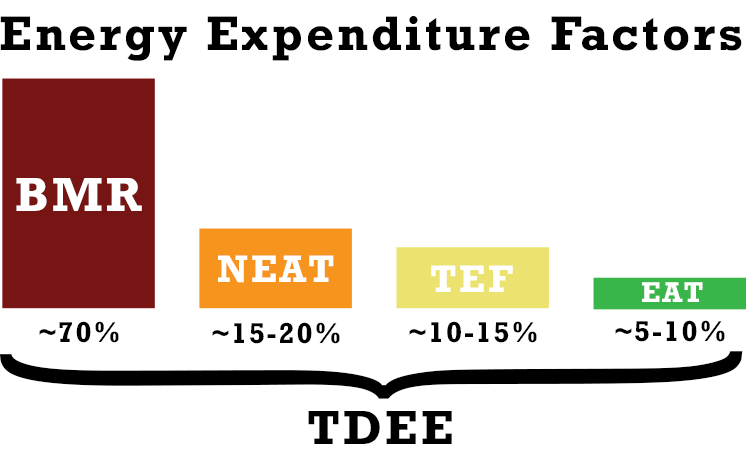
1. Slightly increased BMR:
This essentially means that when we gain weight our body starts burning a bit more calories at rest.
2. Increased NEAT:
The biggest reason why the surplus you set in theory typically isn’t going to be your actual surplus is because of NEAT, or Non Exercise Activity Thermogenesis.
When we eat more, our body usually tries to defend against weight gain by increasing our spontaneous and unconscious movements in order to burn of the excess energy.
This is exactly the opposite of what typically occurs during a fat loss phase.
So when you eat more you may start to unconsciously move more. You may bump your leg on the floor, play with objects, change your position often, and start doing all kinds of spontaneous movements.
In fact, research shows that some individuals burn up to 1000 calories extra per day through these movements when there’s a surplus of calories present.
And this definitely has the potential to cancel out the surplus completely.
3. Increased TEF:
When we eat more food, the energy required for digestion and absorption of the nutrients also increases.
Research has shown that TEF, which is short for thermic effect of food, accounts for about 15 % of the total calories we consume.
4. Increase EAT:
Just as with NEAT, when eating at a surplus of calories, we typically exert ourselves more when we are training. And this is know as EAT, or Exercise Activity Thermogenesis.
Now, to account for these factors, I could have just set the surplus higher in my recommendations, but I choose not to.
And here’s why:
As you’ve just realized, not all individuals are equal. In fact, some people, strangely enough, starts moving less when they start to bulk. This is typically true for people who start/started out as skinny fat, but not always.
This is simply because a surplus of food relaxes these individuals and makes them a bit more lethargic. These same people get stressed and more productive when cutting instead.
So, for that reason, I recommend that you adjust your caloric intake accordingly to what actually happens to your own body weight overtime.
If you want to set up an easy habit that will provide you with very accurate information of what’s going on with your body weight, then check out this article next: How to Measure Fat Loss Progress
*I know the article is named “how to measure fat loss progress”, but the way to measure your progress is the same for fat loss and muscle growth.
Step 2 – Set up Your Macros
Once you have your calories in place the second thing you should look at is your macronutrient intake (protein, fat and carbs).
Setting up your macros and tracking them correctly will help you build more muscle and add less body fat when in a calorie surplus.
How to Set Your Macros
To get the best results possible I recommend sticking to the following macro intake:
- Protein – 0.8-1 gram per lb (1.6-1.8 grams per kg) of body weight per day.
- Fat – 20-30 % of total calories.
- Carbs – The remaining calories left after protein and fat has been set.
If you follow these macro ratios laid out above you will see great workout performance following a high carb intake. On top of that you will get enough protein to support maximum muscle growth as well.
Want to learn more about the macronutrients and why I recommend this specific ratio, read this post next.
What’s Next?
If you follow this information laid out in this post you should start seeing some good results. Now, if you feel overwhelmed then I definitely recommed that you get your hands on a premium step by step guide to follow. This is what I did in the beginning of my fitness journey and I still do so to this day.
If I can take what took someone 10+ years to learn and bring that down to only a few years, why wouldn’t I? When it comes to building lean muscle without gaining fat in the process I recommend the Kinobody Greek God Program. This is a lean-bulking program that I used to totally transform my physique. In other words, the program works!
You can learn more about why I recommend Greg’s kinobody programs here.

MAN i loved it thanks alot for all that great information
Glad you liked it! 🙂